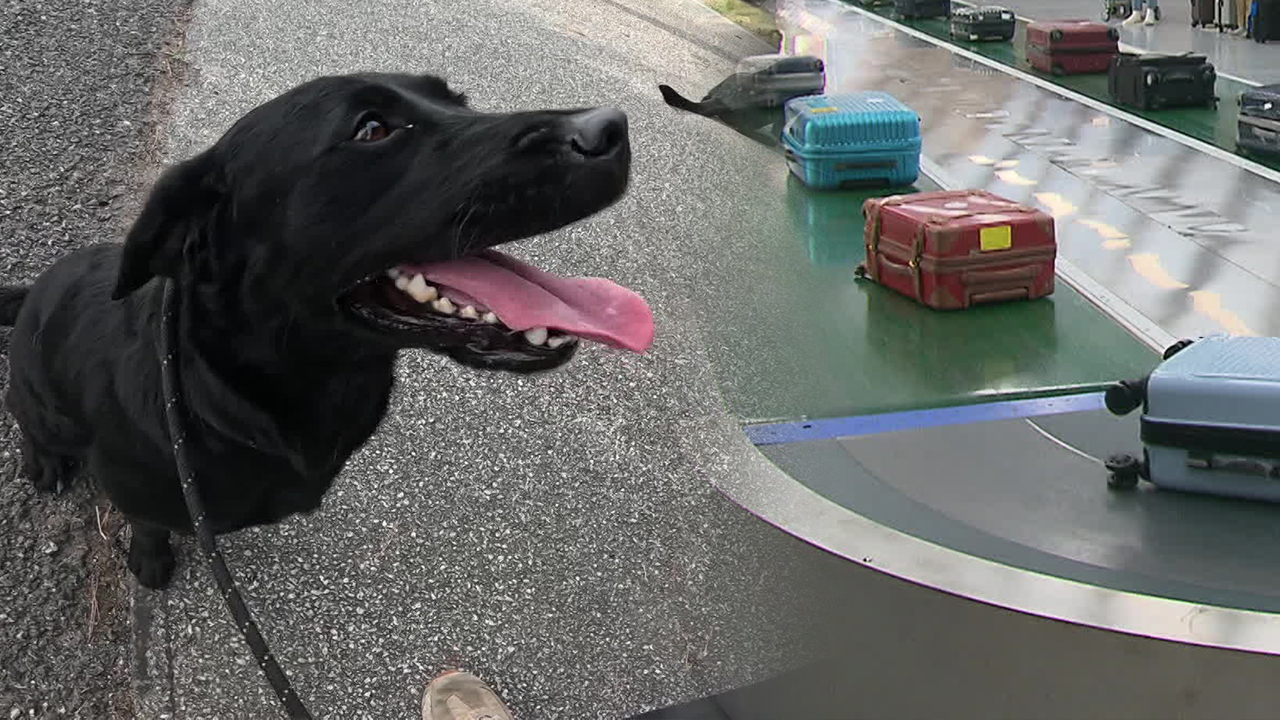Drug dogs outperform AI as customs expands training
입력 2024.11.01 (00:17)
읽어주기 기능은 크롬기반의
브라우저에서만 사용하실 수 있습니다.
[Anchor]
As drug crimes increase, emergency measures are being taken to prevent drug smuggling at airports and ports.
Recently, there has been a trend of increasing drug detection equipment utilizing artificial intelligence.
However, detection dogs that sniff out drugs are still outperforming these technologies.
Reporter Kim Jin-hwa has covered the activities of drug detection dogs.
[Report]
In a space designed to replicate an airport, a Labrador Retriever enters.
It carefully sniffs around and sits in front of a mannequin.
This indicates that it has found drugs.
["Good job! That's right, well done."]
Inside the clothing, ketamine, a type of drug, is hidden.
[Park Jong-soo/Instructor at the Customs Drug Detection Dog Training Center: "We are training them to find various drugs to enhance their skills over time."]
At the Customs Drug Detection Dog Training Center, about 30 trainee drug detection dogs are undergoing training.
The training dogs spend 16 weeks here.
They must pass two tests before being deployed to actual field operations.
Currently, 40 dogs are active at major airports and nine ports across the country, including Incheon International Airport.
For 5 years from 2019, the Customs Service has detected over 3,800 drug cases, with about 16% of these, or one in six, being found by drug detection dogs.
Due to their outstanding performance, requests for drug detection dogs have been made not only by the military and police but also by correctional facilities and education offices in response to the recent surge in drug crimes.
Last year, two detection dogs were sent to Thailand, and training techniques were shared.
[Kim Dong-kyu/Official at the Customs Drug Detection Dog Training Center: "Foreign countries are also asking for donations of dogs, and domestically, as the demand for drugs has increased, other agencies are requesting detection dogs as well."]
Korea Customs Service plans to expand the training center and increase the number of drug detection dogs to 150 by 2028.
This is KBS News, Kim Jin-hwa.
As drug crimes increase, emergency measures are being taken to prevent drug smuggling at airports and ports.
Recently, there has been a trend of increasing drug detection equipment utilizing artificial intelligence.
However, detection dogs that sniff out drugs are still outperforming these technologies.
Reporter Kim Jin-hwa has covered the activities of drug detection dogs.
[Report]
In a space designed to replicate an airport, a Labrador Retriever enters.
It carefully sniffs around and sits in front of a mannequin.
This indicates that it has found drugs.
["Good job! That's right, well done."]
Inside the clothing, ketamine, a type of drug, is hidden.
[Park Jong-soo/Instructor at the Customs Drug Detection Dog Training Center: "We are training them to find various drugs to enhance their skills over time."]
At the Customs Drug Detection Dog Training Center, about 30 trainee drug detection dogs are undergoing training.
The training dogs spend 16 weeks here.
They must pass two tests before being deployed to actual field operations.
Currently, 40 dogs are active at major airports and nine ports across the country, including Incheon International Airport.
For 5 years from 2019, the Customs Service has detected over 3,800 drug cases, with about 16% of these, or one in six, being found by drug detection dogs.
Due to their outstanding performance, requests for drug detection dogs have been made not only by the military and police but also by correctional facilities and education offices in response to the recent surge in drug crimes.
Last year, two detection dogs were sent to Thailand, and training techniques were shared.
[Kim Dong-kyu/Official at the Customs Drug Detection Dog Training Center: "Foreign countries are also asking for donations of dogs, and domestically, as the demand for drugs has increased, other agencies are requesting detection dogs as well."]
Korea Customs Service plans to expand the training center and increase the number of drug detection dogs to 150 by 2028.
This is KBS News, Kim Jin-hwa.
■ 제보하기
▷ 카카오톡 : 'KBS제보' 검색, 채널 추가
▷ 전화 : 02-781-1234, 4444
▷ 이메일 : kbs1234@kbs.co.kr
▷ 유튜브, 네이버, 카카오에서도 KBS뉴스를 구독해주세요!
- Drug dogs outperform AI as customs expands training
-
- 입력 2024-11-01 00:17:34

[Anchor]
As drug crimes increase, emergency measures are being taken to prevent drug smuggling at airports and ports.
Recently, there has been a trend of increasing drug detection equipment utilizing artificial intelligence.
However, detection dogs that sniff out drugs are still outperforming these technologies.
Reporter Kim Jin-hwa has covered the activities of drug detection dogs.
[Report]
In a space designed to replicate an airport, a Labrador Retriever enters.
It carefully sniffs around and sits in front of a mannequin.
This indicates that it has found drugs.
["Good job! That's right, well done."]
Inside the clothing, ketamine, a type of drug, is hidden.
[Park Jong-soo/Instructor at the Customs Drug Detection Dog Training Center: "We are training them to find various drugs to enhance their skills over time."]
At the Customs Drug Detection Dog Training Center, about 30 trainee drug detection dogs are undergoing training.
The training dogs spend 16 weeks here.
They must pass two tests before being deployed to actual field operations.
Currently, 40 dogs are active at major airports and nine ports across the country, including Incheon International Airport.
For 5 years from 2019, the Customs Service has detected over 3,800 drug cases, with about 16% of these, or one in six, being found by drug detection dogs.
Due to their outstanding performance, requests for drug detection dogs have been made not only by the military and police but also by correctional facilities and education offices in response to the recent surge in drug crimes.
Last year, two detection dogs were sent to Thailand, and training techniques were shared.
[Kim Dong-kyu/Official at the Customs Drug Detection Dog Training Center: "Foreign countries are also asking for donations of dogs, and domestically, as the demand for drugs has increased, other agencies are requesting detection dogs as well."]
Korea Customs Service plans to expand the training center and increase the number of drug detection dogs to 150 by 2028.
This is KBS News, Kim Jin-hwa.
As drug crimes increase, emergency measures are being taken to prevent drug smuggling at airports and ports.
Recently, there has been a trend of increasing drug detection equipment utilizing artificial intelligence.
However, detection dogs that sniff out drugs are still outperforming these technologies.
Reporter Kim Jin-hwa has covered the activities of drug detection dogs.
[Report]
In a space designed to replicate an airport, a Labrador Retriever enters.
It carefully sniffs around and sits in front of a mannequin.
This indicates that it has found drugs.
["Good job! That's right, well done."]
Inside the clothing, ketamine, a type of drug, is hidden.
[Park Jong-soo/Instructor at the Customs Drug Detection Dog Training Center: "We are training them to find various drugs to enhance their skills over time."]
At the Customs Drug Detection Dog Training Center, about 30 trainee drug detection dogs are undergoing training.
The training dogs spend 16 weeks here.
They must pass two tests before being deployed to actual field operations.
Currently, 40 dogs are active at major airports and nine ports across the country, including Incheon International Airport.
For 5 years from 2019, the Customs Service has detected over 3,800 drug cases, with about 16% of these, or one in six, being found by drug detection dogs.
Due to their outstanding performance, requests for drug detection dogs have been made not only by the military and police but also by correctional facilities and education offices in response to the recent surge in drug crimes.
Last year, two detection dogs were sent to Thailand, and training techniques were shared.
[Kim Dong-kyu/Official at the Customs Drug Detection Dog Training Center: "Foreign countries are also asking for donations of dogs, and domestically, as the demand for drugs has increased, other agencies are requesting detection dogs as well."]
Korea Customs Service plans to expand the training center and increase the number of drug detection dogs to 150 by 2028.
This is KBS News, Kim Jin-hwa.
-
-

김진화 기자 evolution@kbs.co.kr
김진화 기자의 기사 모음
-
이 기사가 좋으셨다면
-
좋아요
0
-
응원해요
0
-
후속 원해요
0










![[단독] 김민석 총리, 취임 첫 일정으로 ‘송미령 반대’ <br>농민단체 농성장 방문](/data/news/2025/07/03/20250703_YUTdgQ.png)




이 기사에 대한 의견을 남겨주세요.